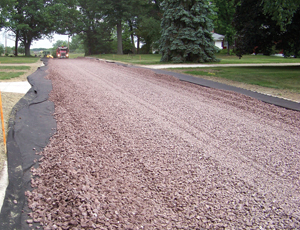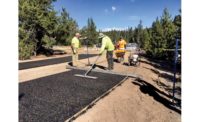As stormwater runoff from streets and parking lots becomes an ever-more sensitive environmental issue, eliminating it altogether with pervious pavement can be an elegant solution.
Two projects now under way in Connecticut and Minnesota have facilities owners, municipal officials and the paving sector taking notice. One involves a parking lot at a university committed to cutting its impervious surfaces by half. The other is a public road in Minnesota, where a city engineer insists he is not experimenting; he is just applying a best-fit solution to a 50-year-old problem. Both applications share one thing in common: they are engineered to eliminate runoff by drinking all the rain that is likely to fall on the pervious concrete.


“This stuff will handle 80 in. of rain per hour,” says Leon Burch, president of Concrete Crafters of CT Inc., Prospect, Conn., as he rolls back a tarp covering a five-day-old slab of 6-in.-thick pervious concrete at the University of Connecticut’s $250,000 parking lot in Hartford. Burch, the concrete subcontractor, opens the tap on a hose and drops the gushing end onto the slab. Instead of splashing and running for the edges, the water disappears. A patch of concrete darkens as all of the water drains through.
The 20,000-sq-ft lot, laid down in 4,000-sq-ft-per-day pours ending on Aug. 20, is a pilot in UConn’s runoff-reduction plan. Brian Gore, the school’s interim director of project and program management, says the lot cost about 25% to 30% more than a conventional one, but there will be savings in the long run from not having to manage runoff.
The job has had a high profile. Environmental regulators are watching closely, as are area contractors that see an opportunity to learn about pervious paving. Tabacco & Son Inc., Bristol, Conn., is the general contractor on the project. Jim Langlois, executive director of the Connecticut Concrete Promotion Council, says, “Expectations are that if pervious works out OK, we are going to start seeing more of it.”
Burch says installation requires strict control of materials. “It is a totally different type of placement—not too difficult. It is just not near as forgiving as standard concrete,” he says. One section placed on Aug. 12 was redone after testing showed it was too dense.
Robert Tabacco, president of the general contracting firm, says 15% void content is the goal. “This concrete should be between 113 lb and 130 lb [per cu ft], but 122 lb is optimum.” He notes that typical paving concrete is 150 lb/cu ft, and the rejected patch tested at 134 lb/cu ft. “It did not give us the right mix ratio,” Tabacco says. “By not having that, we might not have gotten the water filtration we were looking for.”
Construction at another pervious-concrete job stretches ¾ mile over five streets in a lakeside residential neighborhood in Shoreview, Minn. Shoreview city engineer Mark Maloney says pervious concrete was selected because it would accommodate or overcome all the neighborhood’s runoff management issues, as well as make use of local geology. The streets in the 50-year-old residential neighborhood have always drained into Lake Owasso, where declining water quality is a concern. “This is about addressing infrastructure needs,” says Maloney. “We had unique drainage issues.”
The roads are being repaved with 7 in. of pervious concrete on an 18-in.-to 36-in.–thick layer of 1½-in. granular rock spread atop a layer of geotextile fabric. Below that is 40 ft of clean, free-draining sand between the fabric and the static groundwater elevation.
Maloney says primary contractor North County Concrete, Ramsey, Minn., developed enhanced blankets to control concrete curing and adapted roller screeds normally used for bridge paving to guide the screed using the roadway’s concrete curbs. He says the deep layer of sandy soil will ensure drainage and filtration, but, just as in the Connecticut lot, maintenance will require use of vacuum brooms to keep the pavement pores open.


Post a comment to this article
Report Abusive Comment